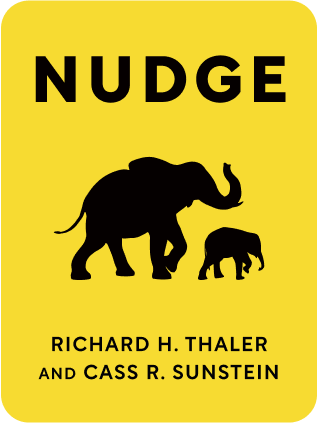

This article is an excerpt from the Shortform summary of "Nudge" by Richard H. Thaler and Cass R. Sunstein. Shortform has the world's best summaries of books you should be reading.
Like this article? Sign up for a free trial here .
What is the Nudge book about? How does Nudge by Thaler and Sunstein address the need to respect free will?
The Nudge book is about the concept of libertarian paternalism. In Nudge, Richard Thaler and Cass Sunstein show how you can respect people’s freedom of choice while also guiding them to choose better options.
Learn more about the key messages in the Nudge book.
Overview of the Nudge Book
Every day we’re constantly faced with choices—what to order at a restaurant, what clothes to buy at a store, what show to stream when we get home from work. We’re so used to making choices that we’re not even aware of the way those choices are presented. If grocery stores didn’t stock candy at the register, would we eat less of it? If we had to “opt out” of being organ donors rather than “opt-in,” would the organ donor pool grow? In Nudge by Richard Thaler and Cass Sunstein, they explain their theory.
Nobel Prize–winning economist and author of Nudge, Richard Thaler and along with legal scholar Cass Sunstein examine how certain choice structures—“architectures,” in their terms—can “nudge” us toward better decisions.
Libertarian Paternalism, Choice Architecture, and Nudges
In Nudge, Thaler and Sunstein (who are devotees of Nobel prize-winning economist Milton Friedman) argued that human beings’ “freedom to choose” is their most fundamental right. But Nudge by Thaler and Sunstein also recognize that humans frequently make bad choices that, if they had another chance, they wouldn’t make again.
The answer to this quandary in the Nudge book is a new movement: libertarian paternalism.
Libertarian paternalism encourages policymakers and private companies to use purposeful “choice architecture” (the way choices are structured and presented) to create “nudges,” subtle hints or influences that move us toward the most beneficial choice.
Although nudges come in an array of styles, there are four primary types that can apply to a broad swath of choice systems:
Thoughtful Defaults
Given Humans’ innate aversion to loss and status quo bias, we are prone to accept the default option when faced with a complex or high-stakes choice—for example, the amount we contribute to our retirement plan or the mortgage terms we agree to. Unfortunately, all too often defaults are afterthoughts: Many choice architects concentrate their efforts on offering more—and more various—choices, expecting people to take advantage of their freedom to choose.
A straightforward way for choice architects to improve people’s choices is to (1) always offer a default option and (2) make sure the default is carefully designed to maximize the chooser’s benefit.
In Nudge, Thaler and Sunstein use real-word examples of nudges that worked. Sweden’s privatization of its social-security program provides a case study in the importance of defaults. The designers of the plan offered a carefully designed default fund, but they also presented citizens with dozens of additional choices and actively encouraged people not to opt for the default. As one would expect, a significant segment of the population—1/3—ended up investing in the default fund. But the majority of Swedes, who weren’t necessarily financially literate, chose their own funds—to their own detriment. The default fund outperformed the individually chosen funds by anywhere from 10%–15%. In this example, the Swedish government gave the right nudge in offering a thoughtful default (but they undermined that nudge by encouraging people not to choose the default).
Another thoughtful use of defaults concerns binary choices, where one must opt in or out of certain programs or situations. Often, a simple change in the default—from “opt-in” to “opt-out” or vice versa—has significant beneficial effects. For example, making enrollment, rather than non-enrollment, the default in a retirement plan vastly increases the number of people saving for their golden years.
Structured Choices in the Nudge Book
When there are few options to choose from—or the choice is low-stakes—humans can distinguish among the options easily and make an informed choice. (An example might be the dollar menu at McDonald’s.)
However, when there are many options, humans are highly prone to err. Nudge by Thaler and Sunstein stresses that it’s incumbent on choice architects to structure large choice sets to minimize humans’ tendency to make mistakes.
An example is tiered retirement-plan options offered by an employer. Tier One is intended for novice investors: It features a default fund, indexed to the market and allocated according to your age. Tier Two features a small choice of funds, categorized as aggressive, conservative, etc., for someone who wants more control over his or her investments. Tier Three features the entire complement of funds for an expert investor who wants complete control over his or her retirement.
Robust Feedback Mechanisms
Many of Humans’ most egregious mistakes occur when they make once-or-twice-in-a-lifetime decisions, for which information and feedback are in short supply—for example, taking out a mortgage or choosing a health insurance plan.
The Nudge book’s answer to mistakes born of insufficient feedback is a regulatory system known as Record, Evaluate, and Compare Alternative Prices (RECAP).
Under a RECAP regime, public and private entities are required to provide clear and replicable reports of all essential data concerning their products. This data can then be used to compare prices, fees, and features with competing products. This contrasts to “fine print” features of contracts or hidden fees.
For example, as it concerns mortgages, RECAP would require mortgage lenders to provide borrowers with an electronic file with the loan’s interest rate, all applicable fees, and a schedule of payments over the life of the loan. The file could then be uploaded into third-party software for comparison with other files uploaded by other users. In other words, RECAP allows Humans to use their Reflective System rather than their Automatic one.
Social Influence
Humans are highly motivated by the behavior of their peers, and choice architects can achieve surprising results simply by framing certain beneficial choices as the social norm.
An experiment conducted in San Marcos, California, illustrates the point. Working with a sample size of 300 households, the researchers informed each household of its energy use over the previous several weeks and also provided the average San Marcos household’s consumption. In the subsequent weeks, the researchers found that the households whose consumption was above the average reduced their consumption. (Unfortunately, they found that social cues work both ways: Households under the average increased their consumption.)
Incentives
Traditional economics relies on the assumption that the prices of goods and services reflect all the relevant information for consumers to make an informed choice. For example, it’s a pretty safe bet that a used car that costs $3,000 will be less reliable or luxurious than a new one that costs $50,000.
But sometimes the relevant economic incentive is obscure, resulting in a greater likelihood of human error. In these circumstances, better choice architecture can make the economic incentives of a given choice more “salient” (or obvious).
A classic example is utility costs. When we crank A/C on a hot day, we may have an inkling that we’re incurring additional cost, but we don’t truly recognize it until we receive our electricity bill at the end of the month. However, if our thermostat displayed the “cost per hour” of our new colder temperature—thereby making the cost of our choice more salient—we might think twice about lowering the thermostat.
The Nudge Book Responds to Objections
Dyed-in-the-wool libertarians might bristle at these sorts of techniques, as they seem to constrain or otherwise corrupt free choice. “It’s a slippery slope from a ‘nudge’ to a ‘mandate’,” they might say.
In Nudge, Thaler and Sunstein offer a three-part response to this sort of objection.
1) Talking about the “slippery slope” sidesteps evaluating libertarian paternalism on its own merits. Does offering a better default retirement plan lead to better outcomes for workers? Does automatic enrollment in retirement plans result in more financially secure seniors? If so, then those suspicious of “big government” should suspend their misgivings. There will always be opportunities later to critique and, if necessary, retrench libertarian paternalistic approaches.
2) Through readily available “opt out” choices, libertarian paternalism always offers an escape hatch. Slippery slopes are steepest when options are limited and there’s no easy way to reverse course. Nudges prioritize choice—there’s always the possibility of opting out, even when the default is “opt-in”—and so the danger of creeping paternalism is limited.
3) Nudges are inevitable. Public and private entities are in the business of choice architecture, whether they want to be or not—there’s no such thing as a “natural” or “neutral” presentation of choices. Thus it makes sense for these entities to nudge people toward the most beneficial choices, as long as choice itself is jealously guarded.
(Although pure neutrality is impossible, there are relative degrees of neutrality. For example, a ballot shouldn’t be designed by a choice architect to favor one candidate over another—rather, the candidates should be randomly ordered and nudges minimized.)

———End of Preview———
Like what you just read? Read the rest of the world's best summary of Richard H. Thaler and Cass R. Sunstein's "Nudge" at Shortform .
Here's what you'll find in our full Nudge summary :
- Why subtle changes, like switching the order of two choices, can dramatically change your response
- How to increase the organ donation rate by over 50% through one simple change
- The best way for society to balance individual freedom with social welfare






